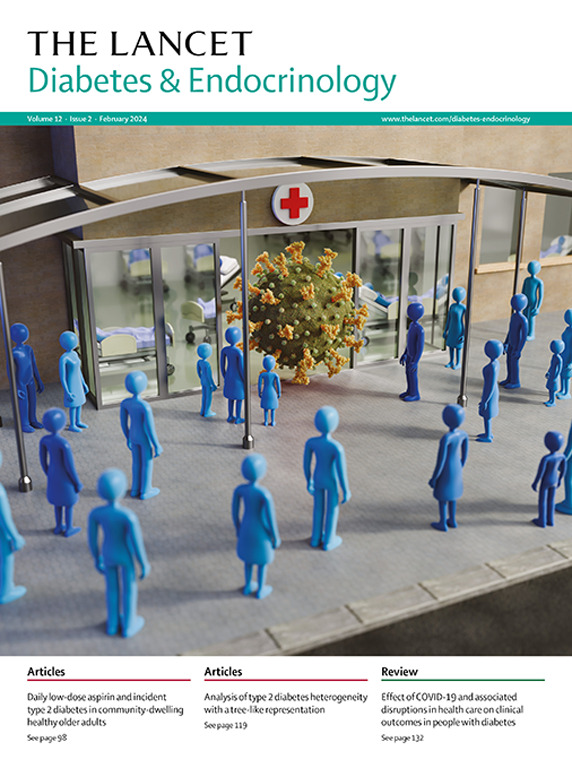Association of gestational thyroid function and thyroid autoimmunity with gestational diabetes: a systematic review and individual participant meta-analysis
IF 44
1区 医学
Q1 ENDOCRINOLOGY & METABOLISM
引用次数: 0
Abstract
Background
Pregnancy is a state of increased metabolic demand that necessitates major changes in endocrine physiology. Gestational thyroid dysfunction and gestational diabetes are common endocrine conditions of pregnancy that frequently coincide. Although the effects of thyroid hormones on glucose metabolism are well documented, important knowledge gaps remain in terms of the extent and clinical relevance of these effects during pregnancy. The aim of this meta-analysis is to assess the association of thyroid function test results with gestational diabetes and markers of glucose metabolism.Methods
In this systematic review and individual participant data meta-analysis, we searched Ovid MEDLINE, EMBASE, and Web of Science from database inception to Dec 12, 2024, for prospective population-based cohort studies with individual patient data on thyroid function, gestational diabetes, and measures of glucose homoeostasis during pregnancy. Furthermore, open invitations to join the Consortium on Thyroid and Pregnancy were issued to identify unpublished datasets. We excluded participants with multiple pregnancies; pre-existing thyroid disease or diabetes; current use of medications that could affect thyroid or glucose levels; or a history of infertility treatment, miscarriage, or stillbirth. Exposures were maternal gestational concentrations of thyroid-stimulating hormone (TSH), free T4 (FT4), free T3 (FT3), and total T3; thyroperoxidase antibody positivity; thyroglobulin antibody positivity; and thyroid disease entities (ie, subclinical hypothyroidism, overt and subclinical hyperthyroidism, and isolated hypothyroxinaemia), which were defined according to current guidelines. The primary outcome was presence of gestational diabetes as defined in individual cohorts. Individual participant data were analysed using generalised linear mixed-effects regression models adjusting for maternal age, BMI, smoking status, parity, ethnicity, fetal sex, and gestational age at blood sampling. We preregistered our study protocol with PROSPERO (CRD42022371927).Findings
We identified 638 published studies with our systematic search, of which 21 studies based on 17 cohorts met inclusion criteria; 11 of these prospective cohort studies provided individual participant data, and data from an additional 14 cohorts were added via personal contacts and open invitations, resulting in a study population of 63 548 participants from 25 cohorts after exclusions. Of the 52 632 participants in 17 cohorts with TPOAb measurements available to define thyroid disease entities, 1687 (3·2%) of these participants had subclinical hypothyroidism, 1153 (2·2%) had isolated hypothyroxinaemia, and 2958 (4·7%) had gestational diabetes. Compared with euthyroidism, isolated hypothyroxinaemia was associated with a higher risk of gestational diabetes (absolute risk 6·5% [72 of 1113] for isolated hypothyroxinaemia vs 3·5% [1555 of 44 787] for euthyroidism; adjusted odds ratio [aOR] 1·52 [95% CI 1·17–1·98], p=0·0017; 45 900 participants). A lower FT4 concentration was associated with a higher risk of gestational diabetes (non-linear, p<0·0001). A higher risk of gestational diabetes was found both with a higher FT3 concentration (aOR 1·18 [95%CI 1·10−1·28], p<0·0001) and with a higher FT3-to-FT4 ratio (non-linear; p<0·0001). No evidence was found of associations of TSH, thyroid antibodies, or other thyroid function test abnormalities with gestational diabetes. I2 statistics for the primary analyses ranged from 0–43%, indicating low to moderate heterogeneity. The funnel plot for overt hyperthyroidism indicated a possibility for publication bias (p=0·049), but funnel plots for all other variables did not.Interpretation
A lower FT4 concentration and isolated hypothyroxinaemia during pregnancy are associated with a higher risk of gestational diabetes. Our results challenge the long-standing notion that subclinical hypothyroidism or thyroid autoimmunity are risk factors for gestational diabetes and support both the risk profile for gestational thyroid dysfunction and ongoing efforts on optimisation of treatment targets for pregnant people taking levothyroxine. Follow-up studies are required to establish to what extent levothyroxine initiation or dose adjustments can affect insulin resistance and antihyperglycaemic therapies during pregnancy.Funding
The Netherlands Organization for Scientific Research, ZonMw, and the EU Horizon 2020 Program.妊娠期甲状腺功能和甲状腺自身免疫与妊娠期糖尿病的关系:一项系统综述和个体参与者荟萃分析
妊娠是一个代谢需求增加的状态,需要内分泌生理发生重大变化。妊娠期甲状腺功能障碍和妊娠期糖尿病是妊娠期常见的内分泌疾病。虽然甲状腺激素对葡萄糖代谢的影响已被充分记录,但在妊娠期间这些影响的程度和临床相关性方面仍存在重要的知识空白。本荟萃分析的目的是评估甲状腺功能测试结果与妊娠糖尿病和葡萄糖代谢标志物的关系。方法在本系统综述和个体参与者数据荟萃分析中,我们检索了Ovid MEDLINE、EMBASE和Web of Science从数据库建立到2024年12月12日的前瞻性人群队列研究,包括甲状腺功能、妊娠糖尿病和妊娠期间葡萄糖稳态测量的个体患者数据。此外,公开邀请加入甲状腺和妊娠联盟,以确定未发表的数据集。我们排除了多胎妊娠的受试者;既往患有甲状腺疾病或糖尿病;目前使用可能影响甲状腺或血糖水平的药物;或有不孕症治疗、流产或死产史。暴露于母体妊娠期促甲状腺激素(TSH)、游离T4 (FT4)、游离T3 (FT3)和总T3浓度;甲状腺过氧化物酶抗体阳性;甲状腺球蛋白抗体阳性;甲状腺疾病实体(即亚临床甲状腺功能减退,显性和亚临床甲状腺功能亢进,以及孤立性甲状腺功能减退症),根据现行指南进行定义。主要结局是个体队列中是否存在妊娠糖尿病。使用广义线性混合效应回归模型对个体参与者数据进行分析,该模型调整了母亲年龄、BMI、吸烟状况、胎次、种族、胎儿性别和采血时的胎龄。我们在PROSPERO (CRD42022371927)预注册了我们的研究方案。结果:我们通过系统检索确定了638项已发表的研究,其中21项基于17个队列的研究符合纳入标准;这些前瞻性队列研究中有11个提供了个体参与者数据,另外14个队列的数据是通过个人联系和公开邀请加入的,排除后的研究人群为来自25个队列的63548名参与者。在17个队列的52632名参与者中,TPOAb测量可用于定义甲状腺疾病实体,这些参与者中有1687名(3.2%)患有亚临床甲状腺功能减退症,1153名(2.2%)患有孤立性甲状腺功能减退症,2958名(4.7%)患有妊娠糖尿病。与甲状腺功能亢进相比,孤立性甲状腺功能减退与妊娠糖尿病的风险较高相关(孤立性甲状腺功能减退的绝对风险为6.5%[72 / 1113],而甲状腺功能亢进的绝对风险为3.5% [1555 / 44787];校正优势比[aOR] 1.52 [95% CI 1.17 - 1.98], p= 0.0017;45 900人)。较低的FT4浓度与较高的妊娠糖尿病风险相关(非线性,p< 0.0001)。较高的FT3浓度(aOR为1.18 [95%CI为1.10−1.28],p<为0.0001)和较高的FT3 / ft4比值(非线性;术;0·0001)。未发现TSH、甲状腺抗体或其他甲状腺功能检查异常与妊娠糖尿病相关的证据。初步分析的I2统计数据范围为0-43%,表明异质性低至中等。显性甲状腺功能亢进的漏斗图显示可能存在发表偏倚(p= 0.049),但所有其他变量的漏斗图没有。妊娠期较低的FT4浓度和孤立性甲状腺功能减退与妊娠期糖尿病的高风险相关。我们的研究结果挑战了长期以来认为亚临床甲状腺功能减退或甲状腺自身免疫是妊娠期糖尿病的危险因素的观点,并支持妊娠期甲状腺功能障碍的风险特征和正在进行的优化孕妇服用左甲状腺素治疗目标的努力。需要后续研究来确定左旋甲状腺素起始或剂量调整对妊娠期间胰岛素抵抗和抗高血糖治疗的影响程度。资助荷兰科学研究组织,ZonMw和欧盟地平线2020计划。
本文章由计算机程序翻译,如有差异,请以英文原文为准。
求助全文
约1分钟内获得全文
求助全文
来源期刊

The Lancet Diabetes & Endocrinology
ENDOCRINOLOGY & METABOLISM-
CiteScore
61.50
自引率
1.60%
发文量
371
期刊介绍:
The Lancet Diabetes & Endocrinology, an independent journal with a global perspective and strong clinical focus, features original clinical research, expert reviews, news, and opinion pieces in each monthly issue. Covering topics like diabetes, obesity, nutrition, and more, the journal provides insights into clinical advances and practice-changing research worldwide. It welcomes original research advocating change or shedding light on clinical practice, as well as informative reviews on related topics, especially those with global health importance and relevance to low-income and middle-income countries. The journal publishes various content types, including Articles, Reviews, Comments, Correspondence, Health Policy, and Personal Views, along with Series and Commissions aiming to drive positive change in clinical practice and health policy in diabetes and endocrinology.
 求助内容:
求助内容: 应助结果提醒方式:
应助结果提醒方式:


